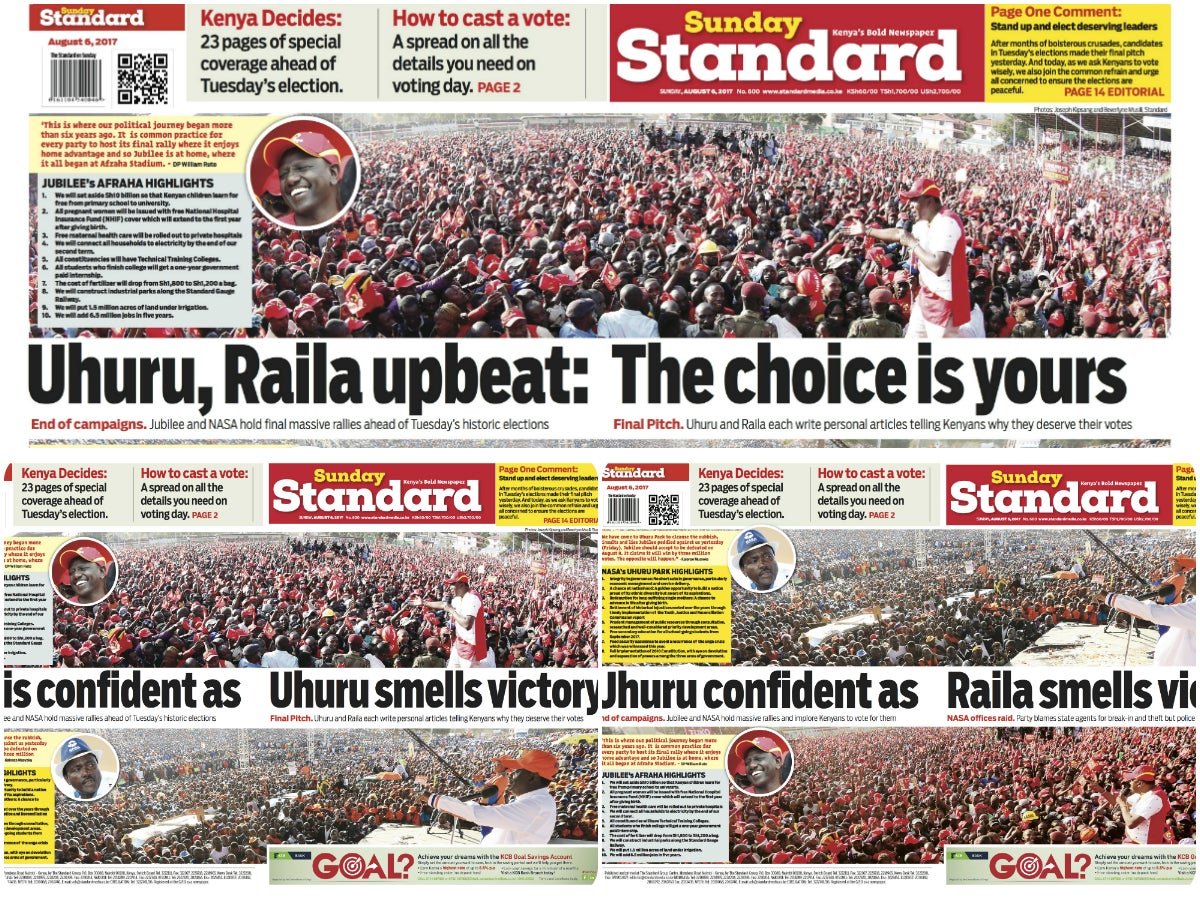Kenya’s newspapers give voters the front pages they want to sell more copies
Kenyan politics is notoriously tribal. The country’s newspapers, local language radio and TV stations have become captive of deep ethnic enclaves that typically rear an ugly head during election seasons. But, for all its deeply parochial nature, such politics has provided rich fodder for the two major newspapers, Nation and The Standard, to appease readers across the political divide with regional-specific headlines and content to drive their sales.


Kenyan politics is notoriously tribal. The country’s newspapers, local language radio and TV stations have become captive of deep ethnic enclaves that typically rear an ugly head during election seasons. But, for all its deeply parochial nature, such politics has provided rich fodder for the two major newspapers, Nation and The Standard, to appease readers across the political divide with regional-specific headlines and content to drive their sales.
With Kenyans heading to the polls on Aug. 8, this practice by the newspapers has become more stark and is the clearest signal of how regional politics defines everything in Kenyan elections.
While this has been the norm for some years now, there are rare occasions when this exercise has inspired criticisms from readers like is the case with the three different editions of The Standard on Sunday on Aug. 6. One of the three editions bore a headline of the main opposition leader, Raila Odinga, optimistic of victory in the Tuesday election. The other had a headline of the incumbent president Kenyatta hopeful of victory. These editions were dispatched to the strongholds of the respective candidates. The third edition carried a headline telling readers the choice (to vote whomever they desired) was theirs. This was aimed at readers in areas that are too close to call.
Standard’s closest competitor, Daily Nation, carries on average three editions (Western, Coast and Mountain/Nairobi) with headlines and lead stories tweaked slightly to suit audiences in the specific regions.
None of this would be controversial but for the growing concern that with polls to close to call, the disappointment of some voters might overspill into violence once again like it did in the 2007 election especially if the results do not match their expectations.
Odinga has traditionally enjoyed healthy support from western Kenya, the Coast region, some parts of the Rift Valley and Lower Eastern (where newspapers tailor messages to appeal to audiences in these regions). President Kenyatta, on the other hand, draws near-fanatic support from Central Kenya, parts of Rift Valley and Upper Eastern. So, in the same stead, the two major newspapers have been sucked into such murky political showmanship by crafting region-specific headlines or lead stories to appeal to the audiences in the target regions to drive sales.
“Regionalism in how a newspaper packages its content has always been the norm in Kenya,” says Paul Wafula, a senior journalist at The Standard.
“People in Central Kenya, for instance, are more interested in news about President Kenyatta, the politicians in the region or on national policies that affect their issues like coffee farming.”
Kenya’s newspapers are aware of the influence they could potentially have on their readers. In January 2008, at the height of the post-election violence, major newspapers all published a similar front page urging citizens to come together and uphold peace. The front-page headline read “Save Our Beloved Country” and showed an unprecedented level of unity among media groups of differing political views.
Kwendo Opanga, a veteran journalist who has had senior editorial positions at Nation and Standard newspapers says both big papers are anchored on the idea that proximity matters when prioritizing news for readers. “People like to read about their region, their heroes or villains, their sports, their politics or what is close to them of affects them first before casting their eyes over the horizon so to speak.”
Ultimately, the key priority seems to be commercial interest. Newspapers in Kenya face the same economic pressures their counterparts face around the world as more readers seek free news and information on the internet.
Since 2014, large media houses in Kenya, including Nation Media Group that owns the flagship Daily Nation newspaper, Standard Media Group, owner of Standard, Radio Africa’s Star newspaper and The People daily have laid off hundreds of workers and shut down some newspaper brands. This has been in response to declining readership, shrinking advertising revenues and escalating competition from a host of emerging digital media enterprises.
“If people like to read about local news, then they are going to buy local news and, therefore, local editions,” says Opanga. “This will translate into more sales and more money as well as help build brand identity, strength and loyalty in the regions.”
But Opanga says whatever their reasons the societal impact of this type of coverage is not net positive. “Do regional editions promote ethnicity or does ethnicity drive regional editions? Another way of asking this question is whether news media, which are businesses or corporate citizens, promote ethnicity at the expense of national unity. Yes.”